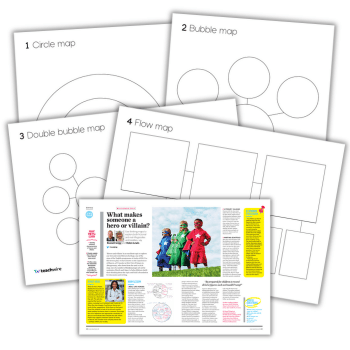7 Strategies To Encourage Genuine Enquiry And An Independent Love Of Learning

We now have the genuine opportunity open to develop a sense of curiosity, and above all to encourage independent thinking.

Learning is changing. The wealth of information at our finger tips is astounding. Gone are the days where primary teachers are forced to plan their lessons from a scheme that dictates which knowledge to impart on students.
Instead, the skills-based curriculum, if you look closely enough, facilitates creativity amongst teachers. Project-based, innovative learning and new ideas can be used to teach skills.
As always in our profession the effectiveness of our teaching relies upon our own reflection and ability to adapt to those we teach, but now we have the genuine opportunity open to us to instil a love of learning; to develop a sense of curiosity and enquiry, and above all to encourage independent thinking.
The difficulty, though, can often be where to start. How do we engage pupils effectively to want them to learn for themselves?
As a lover and advocate of project-based and cross-curricular learning, my advice would be to keep it simple. If you want to build on achievements, make your goals achievable. Reflect on your mistakes and actively seek out support and advice to turn them into successes.
Developing independent learning in the classroom takes time. It is not simply about the learning but in fact the attitude towards the learning journey.
It involves having an awareness of all of those who are on the journey and thinking about how each and every one can add to the achievements.
Ultimately an independent love of learning will reach far beyond the walls of the classroom. The aim is to have a love of learning stay with that child for life.
1. Relationships and learning
Relationships are key in the learning environment. Getting to know who you have in the room is essential. Learn about them, seek out their sense of humour and what they love to talk about. Talk to your students about who they are. The communication does not need to be purely about the curriculum. For it to be open and fully effective it will need you to know them as individuals.
The biggest success for me has been to allow my students to see who I am as an individual.
This does not mean I share with them every last detail of my weekend, but it does mean is that I allow them to see my sense of humour, that I love cats, that I have a pet hate of anyone being unkind to others, and that I will always listen.
My students do not need to see me outside of school to know that I am human. They know that I love teaching but they are also aware that there is more to me than just the classroom.
By sharing, for example, my own enthusiasm for writing or for learning about anything historical, they see what makes me tick. We are all accepted as individuals with different likes and dislikes. That is what makes us unique and what brings an added layer to our learning.
2. Mindset and Building Learning Power
Put aside all you know and open your mind. Envisage an environment where independent thinking and learning is encouraged and nurtured; where the children are able to demonstrate an appreciation of being ‘stuck’, and where there is quite literally a genuine ‘buzz’ for learning beyond anything I have ever experienced before.
Where I work at West Thornton Primary Academy, this is how we learn.
A growth mindset school, West Thornton’s pupils are familiar with ‘being stuck in the pit’, a phrase used to describe the task of navigate your way through challenging work.
Being ‘stuck’ is a good thing. The children understand that not all learning is easy; mistakes are positive.
From an early age the students are taught to deal with challenges. Perseverance, resilience and determination are the foundations of their learning power.
As the teacher it is essential to develop your own growth mindset. Through modelling this approach and making it an intrinsic part of the learning, the results can be simply staggering.
Children relish the opportunity to be ‘stuck’. They opt for the more challenging or interesting task and the winder comes when they show the determination to succeed and perseverance to keep at the learning until they feel a sense of achievement. If we can’t do it – we can’t do it yet. It’s a simple mantra, but it works.
3. Learning to enquire
Within the learning space at West Thornton, children have a working ‘Wonder Wall’. The wall is home to the children’s ‘wonders’. It is a place to add their thoughts, feelings and questions throughout their learning journey.
Curiosity is essential. It is part of the learning. Questions are welcomed and nurtured as tools for learning.
Very often we link the learning to the Wonder Wall, using the questions or curiosity to drive the next stage of the learning. In doing so we allow the children to see the benefit of their wonders. We enable them to see where there wonders can take them and how their own thoughts and thinking can evolve into knowledge and skills.
4. Owning the learning
We enable the children to own their learning. In the learning zone there is an ‘Edit Bench’. This is a place for the children to go to up-level and improve their work. It prompts the children to think about what else they need to learn or improve, and in doing so acts as a place where self- and peer-assessment can take place.
The ‘Pit Stop’ provides a place to locate resources. If a child becomes aware that he needs something additional to assist him with his learning, he will go to the Pit Stop to find it.
At West Thornton the children have their own ‘Independent Learning Toolkits’, inside of which are the simple ‘tools’ for learning like pencils or pens. They enable children to be mobile within the space, but also enable them to focus on their learning. Everything they need is in their toolkit. The time lost in hunting for the missing pencil is now spent learning.
A special feature of West Thornton is that the children choose where and how they work, which may, for example, be up in the ‘Learning Tower’. They do not wear shoes in these zones; they are working in an environment which allows them to relax and feel comfortable. The beauty of this is that it enables us to cut through the time spent settling in to the learning. Who is sitting where no longer takes up valuable learning time.
The ‘Big Question Wall’ is where the children will find all of their independent learning challenges. They learn to manage their own time and prioritise their work. In addition to independent challenges, the children attend focus lessons and surgeries to progress their learning.
Through encouraging them to take an active role in making decisions which relate to their own learning, for example by giving them the opportunity to choose to attend a surgery to help with their understanding, we empower them to want to achieve.
5. Celebration
One of the key successes in instilling a love of learning is sharing. New nuggets of knowledge, tips for learning – these are all valuable shares in the classroom.
It is not just about the final result and how it looks. It is about the journey which has led you to that result. Sharing mistakes, unpicking failures to enable them to become successes is essential to instilling a love of learning. Einstein said, ‘I have tried 99 times, but on the 100th time came success’.
If children understand that learning is a journey and both successes and failures are part of that learning, they will take risks. It is the risk-taking which very often facilitates the path of success to be found. Developing this ethos in the classroom can be key to making it a safe place to learn.
6. Technology
Using technology in the learning environment opens up new channels of discovery. Technology can often frighten teachers but if you face the fear, it is possible to see a whole world of new enquiry suddenly appear.
I learn with my students. We learn together. Our digital leaders assist with the use of technology and share their expert knowledge and we use the technology in ways that help us to advance the learning.
QR Codes are regularly used to access sources or challenges and a Padlet wall is continually available for them to add their ideas and suggestions.
The children blog to develop and improve their writing. They understand that there is a wider audience who will read their work and as a result they want to write for that audience.
They have a choice of technology available to them. They know to consider which is more useful for their current task. Giving peer feedback using Explain Everything might be happening at one end whilst making a video to demonstrate learning may be happening at another. We keep it simple, but in doing so we make it effective.
Technology can be used to hook the children into their learning. Our children were thrilled to see what they would look like in 60 years time and they were able to as a result of an app. From this they began to research the life of Martin Luther King to find out about his life journey. Writing and recording their own ‘I have a dream’ speech involved developing skills which can be used for life in all areas.
7. Love Learning
Above all, to be able to instil a sense of curiosity and a love of independent learning, the best way is to embrace it and dive in.
If the children you teach see how enthusiastic you are about learning new skills and developing your understanding of knowledge, if they see you ask questions and ‘wonders’ they will follow suit.
They need to know that you love learning!
We all know that the teachers we remember the most are those that made the learning memorable for us. That was because they truly understood the children they were teaching and they had their own passion for learning.
If you are the teacher that the children will remember in years to come you’ll be surprised at how far they are prepared to travel into the unknown with you. It just needs to start with that first step – together.
Claire Bracher is an Assistant Headteacher at the West Thornton Primary Academy in Croydon, working on School Improvement. Claire is a full-time class teacher with a passion for teaching and learning, but is particularly interested in project-based, cross-curricular learning and growth mindset for children.











